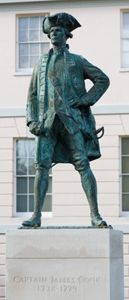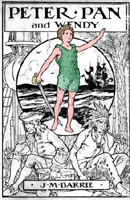The Real Life and
Fictional Characters Who Inspired J.M. Barrie's Captain Hook
This article was written by Rachel
McGinnis
|
|
The Real
Life and Fictional Characters Who Inspired J.M. Barrie's Captain Hook This article was written by Rachel
McGinnis
Captain Hook has been immortalized as one of the
greatest, most infamous villains in literature. Created by James
Matthew Barrie in his play in 1904 and restored for a number of novels and
stories in 1911, this character has been making readers shudder from his
sinister behavior for over a century. Who could forget his cadaver-like
appearance or his melancholy blue eyes that burned a fiery red when he became
angry or violent? For that matter, who could forget his hook that was
used to menace both his enemies and his crew? He was the fearless
captain of the Jolly Roger whose only apprehension stemmed from the sight of
his own blood, which was described as strangely colored and thick, and was
said to be the only man that Barbecue, Captain Long John Silver of Treasure Island, feared. Barrie revealed in his speech, "Hook at
Eton," which was delivered to Eton pupils in 1927, that the fictional
Captain James Hook was a former student of Eton College and indicated that
disclosing the identity of this character would create a scandal, implying
that he was someone of great importance prior to his transformation into the
barbaric captain. Captain Hook's gentleman background is apparent
through his maddening concern for maintaining good form although his reaction
to others that illustrate good form, such as Smee and Peter Pan, is hardly indicative
of a gentleman or the like. He is an exceptionally strange and
convoluted character, both a villain and a gentleman, which begs the question
what inspired J.M. Barrie to create such an elaborate and complicated
scoundrel? Who was J.M. Barrie's muse when he developed this character?
Although there are several theories regarding the
inspiration for Captain Hook, none have been indefinitely proven as the
source of Barrie's creativity, nor did Barrie reveal a particular individual
that led him to author Captain Hook. Both factual and fictional
individuals have been cited as potential sources, with the earliest
nonfiction source being the English sea captain Christopher Newport. Captain Christopher Newport was, among other things,
a 16th century privateer employed by Queen Elizabeth I of England.
Given that the line between piracy and privateering has historically been
blurred, his employment as a privateer is one of the most profound
similarities connecting him to Captain Hook. Having analogous premises,
the primary difference between the occupations was that privateers where
employed by a respectable company that funded the excursions and took a
portion of the cargo that was seized by the privateers, while pirates were
not associated with any sort of organization and retained the expropriated
cargo. Christopher Newport is famed for having led more attacks on
Spanish ships and settlements than any other English privateer, which led to
a somewhat infamous reputation and potentially created a basis for Captain
Hook. Newport was a privateer for roughly twenty years
and, during this time, presented King James I with two baby crocodiles to
satiate the king's lust for exotic animals. Barrie;s use of a crocodile
in the story Peter Pan is
possibly based on Newport's presentation of this unusual, fierce animal to
the king. Additionally, Christopher Newport was largely identified as a
man of the sea who repeatedly left his wife in order to complete five
dangerous voyages across the Atlantic Ocean indicating that, similar to the
captain, he was both courageous and lacked a female presence for a large
segment of his adult life. Nonetheless, perhaps the most striking similarity
between Captain Hook and Captain Christopher Newport was that both were
missing a hand. After leading his crew onto an enemy ship off the coast
of Cuba, Newport lost his arm in the battle and shockingly replaced it with a
hook. Similar to Barrie's Captain Hook, Newport lost his right hand
although many contemporary film versions, such as the film Hook, inaccurately portray this
character without a left hand due to the difficulty of completing everyday
tasks without the supposedly dominate right hand. Although there are a number of similarities between
the legendary Christopher Newport and the fictional Captain Hook, there are a
number of stark differences. Captain Newport was renowned for treating
Natives with respect, using trade to procure their cooperation, which is
entirely distinct from the warring relationship J.M. Barrie depicts between
Captain Hook and the Redskins of Neverland. Additionally, Newport
reportedly used persuasion, eloquence, and example to control and command his
crew. During a time in which hangings at sea and various other brutal
methods were popular forms of punishment for unruly crews, Newport's approach
to discipline was singular and unique. His concept of maintaining order
was also very different from Captain Hook's who repeatedly threatened to use
violence and his hook to maintain thoughtless obedience.
Alternatively, it has been proposed that J.M. Barrie
was inspired by various other fictional characters he was exposed to prior to
composing his story, Peter Pan.
Treasure Island, which was
written in 1883, contains Captain Long John Silver who, similar to Captain
Hook, was yet another malignant sea captain known for his duplicity.
Although he is a literary figure renowned for his treachery and
deceitfulness, Silver is initially portrayed by Robert Louis Stevenson as a
kind, polite, almost gentlemanly figure and was based on William Henley, a
crippled, clever friend of the authors. Silver is repeatedly described
as merry, cheerful, and intelligent and only later does he become the dreaded
Captain Long John Silver who lacks concern for loyalty or human life.
Similar to Captain Silver, Captain Hook is an educated man described as both
ruthless and gentlemanly. It is perhaps from Captain Silver that Barrie
was inspired to create an educated man that chose a life of piracy and
treachery. Evidence of Barrie's knowledge of Captain Silver is apparent
from his reference to the "Sea Cook" and "Barbecue" in
his novel, which are alternative names for Captain Long John Silver. An additional similarity between Captain Silver and
Captain Hook is the loss of a limb, although Captain Hook lost his hand that
is replaced by a hook, while Captain Silver lost a leg that is not
replaced. Instead, Silver used a crutch and was exceptionally dexterous
and able-bodied, which is similar to Captain Hook who prefers and values his
hook so highly that he proclaims he would pray for his children to be born
with hooks instead of hands. An additional difference between the
characters is their appearance. While Captain Hook resembles a cadaver
and has a dark complexion and eyes that occasionally emit a red glow, Captain
Silver is depicted with pale skin and is consistently portrayed as robust and
full of life. Finally, Captain Silver is married to a woman of African
descent while Captain Hook does not have any interaction with females, which
prompts him to kidnap Wendy Darling so that she can become a mother for him
and his crew. Another fictional character that possibly inspired
Barrie's representation of Captain Hook was Captain Ahab of Moby Dick, which
was published in 1851. Captain Ahab, similar to Captain Hook, was
depicted with a black face and eyes that glowed like coals, "eyes of red
murder." Both Herman Melville and J.M. Barrie used the archetypal
imagery of a darkened countenance to illustrate the astounding villainy of
Captain Ahab and Captain Hook. These men were the primary sources of
evil in the stories and, as such, were given dark complexions that contrasted
with the pale skin of the various other (apparently less evil)
characters. The captains had unique appearances that created the faade
of foreignness and, given the historical fear of the nonnative and unknown,
their appearances made them increasingly frightening to the reader.
Although there are a number of similarities between
certain factual and fictional figures, there is no way of knowing which
individuals may have inspired J.M. Barrie to create his degenerate and
infamous Captain Hook. Without Barrie's acknowledgement of a particular
biographical inspiration, it can only be surmised that Barrie's inspiration was
possibly one of these individuals, a combination of these potential sources,
or the result of an unknown individual that Barrie was personally acquainted
with during his lifetime, such as the Davies children who inspired him to
compose the story of Peter Pan.
Regardless, Barrie's combination of Captain Hook's unique traits guarantees
that this disreputable character will without a doubt continue to live on in
infamy. |
||||||
© http://www.literarytraveler.com/authors/captain_hook.aspx
© Copyright
1998-2008
OTHER INTERESTING
ARTICLES: Next [1] [2] [3] [4] [5] [6] [7]
Academic year
2008/2009
© a.r.e.a./Dr.Vicente Forés López
©Marta Soler Gamero /marsoga@alumni.uv.es
Universitat de Valčncia Press


